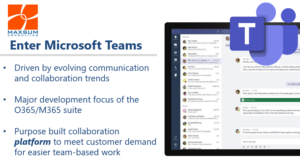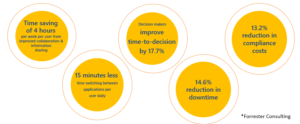7 Steps to a Successful Microsoft Teams Strategy!
In the world of business technology, Microsoft Teams, and the cross-business collaboration it powers, is the talk of the town.
At our recent Create, Collaborate, Coordinate with Microsoft Teams event, Maxsum unpacked what the big deal with Teams really is, what it can help you deliver in your business, and how to plan your journey for real success with Microsoft Teams.
The key takeaway? Whilst Teams definitely delivers the quick wins, long-term success is dependent on a well-planned and implemented strategic approach.
Catch up here on all the top talking points from the event and for our 7 Steps to a successful Microsoft Teams strategy!
Step 1: Understand that we’ve changed the way we work!
It’s a mobile-first, cloud-first world these days. The need to create, collaborate and coordinate across both remote and in-office teams is paramount.
We already know that 80% of employee time is spent collaborating and that 72% of workers will be working remotely by 2020…
The big question this is, how do we unify the collaboration experience while providing the customisation options individual teams need?

Step 2: Get better at answering the new-age question: To app or not to app?
You find a great app or SaaS product, it seems easy to use, so you whip out the credit card, click to download and presto, you’re up and running, right? Today, there’s an application for pretty much everything, but this in itself has presented a host of different problems – Dispersed resources, inefficient co-authoring and file sharing, security concerns from shadow IT with still little real support for a truly mobile workforce.
Plus different groups require different tools… whether it’s content management, finance or operations, there’s no one-size fits all solution for any organisation, and that’s where Microsoft Teams comes into play. All the common and more specific apps you need are delivered and accessible via a centralised, customisable platform.

Step 3: Recognise that Microsoft Teams is a fundamentally different way of working
Despite using many of the same tools, every group within an organisation is different.
With Microsoft Teams, you can structure each group or “team” to suit the needs of the users accessing it/belonging to it. Driven by evolving communication and collaboration trends, Teams is a purpose-built collaboration platform.
Build out team workspaces, share instant messages, host a conference call, file share and integrate external applications – Microsoft Teams can serve as a centralised hub of information across your organisation.

Step 4: Try it out and see that with Teams, the technology is actually the easy part!
Don’t believe us? See for yourself how simple and easy teams-based collaboration actually is!
Step 5: Lay the groundwork BEFORE you press go!
Ok – so what we know already about digital transformation is:
- 25% of technology projects fail outright
- 70% of change programs fail
- 84% of companies fail at Digital Transformation
So what happens when you dive feet first into Teams but…
- Your teams’ usage of it is very ad-hoc and you feel like you have information everywhere
- You don’t really know what success with Teams even should look like or how you can measure it
- You’re not reaping the productivity benefits Teams promised…
These are clear signs that you haven’t laid the foundations to support the shift to teams-based collaboration.
This means is working with an internal team of champions in your organisation and your technology provider to make sure you’ve identified:
- Clear vision, aims, and scope
- Clear goals and milestones
- Definite internal champions
- Key governance discussions
- Key security & compliance discussions
- Key lifecycle & retention policies
- Select preferred features
- Clear business processes
- Monitoring & metrics
- Plan for onboarding, training and adoption support
- The right licensing and the right systems
Covering off on all these points involves going through a rigorous scoping and planning process to build out your Microsoft Teams strategy and support your implementation and adoption of Microsoft Teams.
Step 6: Know what success can look like and work towards it!
Thanks for Microsoft and Forrester’s excellent study into the tangible economic impact of Microsoft Teams delivers into organisations, we now know that strategically planned, properly implemented, promoted and adopted organisation wide, Microsoft Teams can deliver some awesome business gains!

Set and measure your goals, tailor your in-house training and onboarding to ensure that
- your team understands and are working towards the same goals,
- that teams-based collaboration actually gets embedded in your organisation, and
- that you have a way of actually celebrating your successes.
Step 7: Ensure your team is in it for the long-haul
Microsoft Teams represents a fundamentally different way of working and moving to Teams-based collaboration WILL have an impact on the way your team works, communicates and produces results. It will change business processes, operations and the way your team communicates – for the better – if strategically planned and implemented.
But it’s a long game that’s more about your people than the tools! Success will be contingent on, not just your Microsoft Teams strategy, but on having right champions along for the ride in your business who are engaged and invested in the Teams adoption process for the long-haul.

Next steps?
- Keen to get started using Teams, but want to get it right?
- Suddenly realised you’ve jumped right in but haven’t laid the groundwork?
- Just want to test the waters and find out more about the functionality of Microsoft Teams?
Now is your chance – Give us a call on 1300 629 786 (MAXSUM) or sign up now for a Teams jump-start consultation!




